2012年11月02日
The Path to Paradise
If you make it to Busshozan (http://cathy.ashita-sanuki.jp/e601037.html), be sure to visit Honenji Temple.
In the “old days”, temples often provided visual “attractions” in the form of pictures and sculptures as a way of teaching illiterate followers. Honenji Temple, however, did this on a very grand scale.
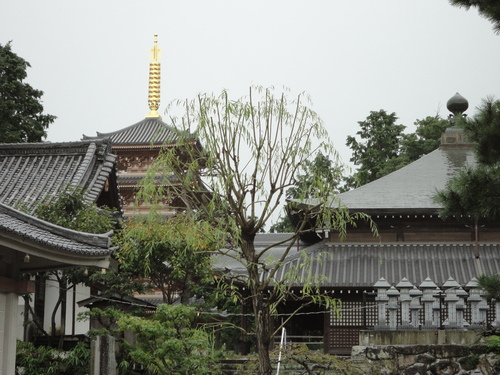
Part of Honenji complex
Built in 1668, the temple complex was designed as a 3-dimensional representation of the “Pure Land” (paradise) and the path the soul travels to paradise when it leaves the physical world.The other day, some friends and I tried following this path. Unfortunately, we completely missed the first leg of the journey because it begins outside the temple grounds at a little shrine. Across from it, is the beginning of a white stone path and a wooden building. We saw the path and building, but were ignorant of their significance.

The path, we later learned, symbolizes the way of pure faith, which leads faithful souls safely through the hell of water and of fire. Inside the building, the king of Hades waits to judge the deceased. Hopefully, being now informed, you will be able to pay your respects properly! After passing through these ordeals (and a gate)

..the deceased at last reaches the entrance to paradise, the Nio Gate (on the left of the pagoda). On either side of the gate stand two large statues of Nio, guardians of the Buddha.

One statue's mouth is open

…and the other's is closed.
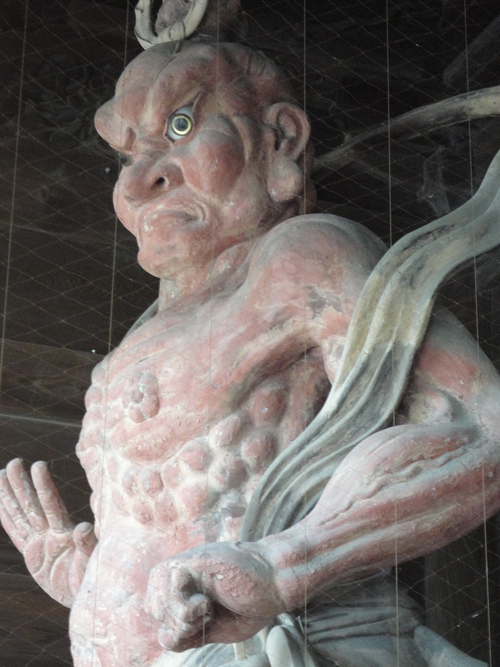
This signifies the beginning and the end (like the Alpha and Omega in Christianity). The path beyond is lined with stone lanterns to light the dark and seemingly endless road to paradise.

A flight of stairs leads to another massive gate, in which two Buddhas are enshrined.
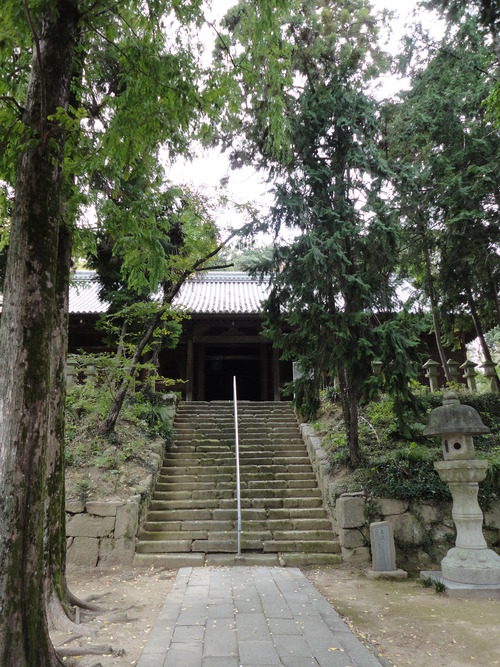
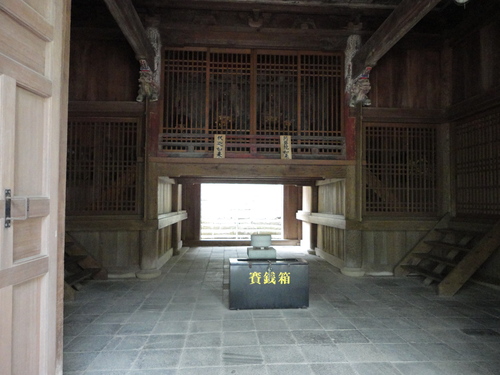
This is followed by another steep flight of stairs, and I do mean steep,

that lead to Raigo-do,

a bell-tower guarded by beautiful Kannon, one on each side.

Here the Buddha welcomes the deceased by continuously ringing the bell. We, of course, rang it ourselves.

The bell-tower is followed by guess what? Yes! Another flight of stairs!

Although the temple often seems deserted, the well-worn treads testify to centuries of faithful worship.
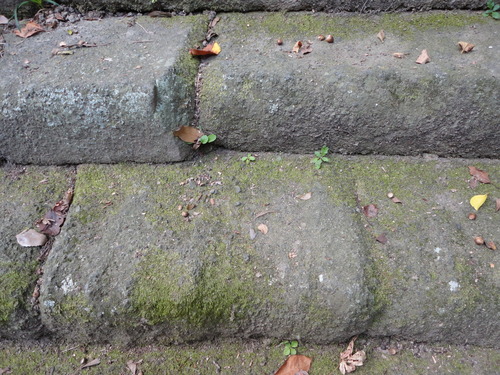
Finally, the traveler reaches “paradise”: the top of the hill where the tombs of the lord’s family and other important people are located.
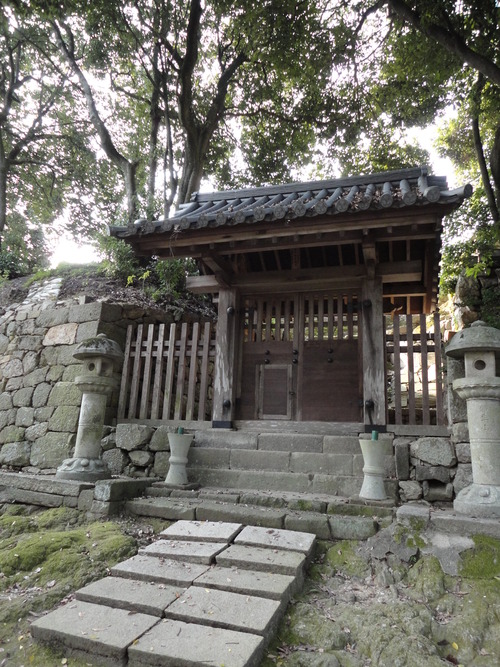
When I first discovered this temple many years ago, the gate to the tombs was in disrepair and anyone could go in. It has since been fixed and locked so now you must be content with a glimpse of what’s inside.

The lovely view from the top, however, is reward enough.

The journey certainly reminded us that getting into paradise requires effort!
Stay tuned for a peek inside the temple itself in my next post.
Access:
Kotoden train: Take the Kotohira line from Takamatsu Chikko station (near Takamatsu JR station) to Busshozan station (620 yen round-trip, 3 trains/hour; about 18 min. ride). Turn left (east) when you exit Busshozan station. Walk past a few streets and turn right (south) at the 4-way intersection. Follow the road until it comes to a hill. Bear right and go around the hill until you see a big pond. On the left you should see the 1st small shrine and on your right, the white stone path leading to the temple. (About 15 min. walk from the station.)
Many thanks to Yui for her explanation of all the symbolism.
In the “old days”, temples often provided visual “attractions” in the form of pictures and sculptures as a way of teaching illiterate followers. Honenji Temple, however, did this on a very grand scale.
Part of Honenji complex
Built in 1668, the temple complex was designed as a 3-dimensional representation of the “Pure Land” (paradise) and the path the soul travels to paradise when it leaves the physical world.The other day, some friends and I tried following this path. Unfortunately, we completely missed the first leg of the journey because it begins outside the temple grounds at a little shrine. Across from it, is the beginning of a white stone path and a wooden building. We saw the path and building, but were ignorant of their significance.
The path, we later learned, symbolizes the way of pure faith, which leads faithful souls safely through the hell of water and of fire. Inside the building, the king of Hades waits to judge the deceased. Hopefully, being now informed, you will be able to pay your respects properly! After passing through these ordeals (and a gate)
..the deceased at last reaches the entrance to paradise, the Nio Gate (on the left of the pagoda). On either side of the gate stand two large statues of Nio, guardians of the Buddha.
One statue's mouth is open
…and the other's is closed.
This signifies the beginning and the end (like the Alpha and Omega in Christianity). The path beyond is lined with stone lanterns to light the dark and seemingly endless road to paradise.
A flight of stairs leads to another massive gate, in which two Buddhas are enshrined.
This is followed by another steep flight of stairs, and I do mean steep,
that lead to Raigo-do,
a bell-tower guarded by beautiful Kannon, one on each side.
Here the Buddha welcomes the deceased by continuously ringing the bell. We, of course, rang it ourselves.
The bell-tower is followed by guess what? Yes! Another flight of stairs!
Although the temple often seems deserted, the well-worn treads testify to centuries of faithful worship.
Finally, the traveler reaches “paradise”: the top of the hill where the tombs of the lord’s family and other important people are located.
When I first discovered this temple many years ago, the gate to the tombs was in disrepair and anyone could go in. It has since been fixed and locked so now you must be content with a glimpse of what’s inside.
The lovely view from the top, however, is reward enough.
The journey certainly reminded us that getting into paradise requires effort!
Stay tuned for a peek inside the temple itself in my next post.
Access:
Kotoden train: Take the Kotohira line from Takamatsu Chikko station (near Takamatsu JR station) to Busshozan station (620 yen round-trip, 3 trains/hour; about 18 min. ride). Turn left (east) when you exit Busshozan station. Walk past a few streets and turn right (south) at the 4-way intersection. Follow the road until it comes to a hill. Bear right and go around the hill until you see a big pond. On the left you should see the 1st small shrine and on your right, the white stone path leading to the temple. (About 15 min. walk from the station.)
Many thanks to Yui for her explanation of all the symbolism.
My Profile
Cathy Hirano キャシー ヒラノ
I've lived in Japan since 1978. After graduating from a Japanese university with a BA in cultural anthropology in 1983, I worked as a translator in a Japanese consulting engineering firm in Tokyo for several years. My Japanese husband and I moved to Takamatsu in 1987 to raise our two children in a slower-paced environment away from the big city pressures. We've never regretted it. I work as a freelance translator and interpreter and am involved in a lot of community work, including volunteering for Second Hand, a local NGO that supports educational and vocational training initiatives in Cambodia, and for the Takamatsu International Association. I love living in Takamatsu.
Cathy Hirano キャシー ヒラノ
I've lived in Japan since 1978. After graduating from a Japanese university with a BA in cultural anthropology in 1983, I worked as a translator in a Japanese consulting engineering firm in Tokyo for several years. My Japanese husband and I moved to Takamatsu in 1987 to raise our two children in a slower-paced environment away from the big city pressures. We've never regretted it. I work as a freelance translator and interpreter and am involved in a lot of community work, including volunteering for Second Hand, a local NGO that supports educational and vocational training initiatives in Cambodia, and for the Takamatsu International Association. I love living in Takamatsu.
Posted by cathy at 22:05│Comments(2)
この記事へのコメント
Great post Cathy.
I haven't made it back there since our visit last month, but I can't wait to climb those stairs too (although I may wait for the Spring now.
I haven't made it back there since our visit last month, but I can't wait to climb those stairs too (although I may wait for the Spring now.
Posted by David at 2012年11月02日 23:53
先日はご案内ありがとうございました。
また一緒に行きたいです。Davidさんとも一緒に行けるといいなあ。
また一緒に行きたいです。Davidさんとも一緒に行けるといいなあ。
Posted by Hiroko at 2012年12月08日 00:31
※会員のみコメントを受け付けております、ログインが必要です。





